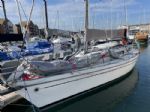











| Rossiter Pintail Mortagne sur Gironde, near Bordeaux |
 |
| Laser 140101 Tynemouth |
 |
| Laser 28 - Excellent example of this great design Hamble le rice |
 |
List classes of boat for sale |
Proper Course |
Post Reply 
|
Page <1234> |
| Author | ||
Scooby_simon 
Really should get out more 
Joined: 02 Apr 04 Location: United Kingdom Online Status: Offline Posts: 2415 |
 Post Options Post Options
 Quote Quote  Reply Reply
 Topic: Proper Course Topic: Proper CoursePosted: 27 Feb 08 at 9:54pm |
|
Excellent post Ian. Sums up why this is so difficult to do on a forum. |
||
|
Wanna learn to Ski - PM me..
|
||
 |
||
iansmithofotley 
Far too distracted from work 
Joined: 16 Mar 04 Location: Otley, West Yorkshire Online Status: Offline Posts: 209 |
 Post Options Post Options
 Quote Quote  Reply Reply
 Posted: 27 Feb 08 at 8:13pm Posted: 27 Feb 08 at 8:13pm |
|
|
Hi everyone, It just shows how complicated the rules are as many experienced sailors have responded to this topic having had access to rule books and lots of time to think about the scenario. After all this consideration there is still quite a bit of disagreement and lots of different opinions. Nevertheless, whilst racing, we all have to make decisions like this in split seconds, often in strong winds, in testing conditions, when surrounded by many other boats (often of all different types with different sail plans) and in testing high performance boats. I think that the topic has been a great source of learning for us all. Redback said in his original post that the matter was resolved informally and in good spirit, which is great. I think that part of the problem, now that we have all had chance to study the situation, is that we really needed more information to decide which rules apply. I realise that initially it was just a brief, interesting, post by Redback who I suspect might be quite surprised with the amount of interest in the topic. However, situations like this happen all the time in club racing, open meetings and championships. I think that the problem has become more prevalent since the glut of asymmetric boats over the past fifteen years and particularly with asymmetric boats sailing against non-asymmetric boats. The ‘proper course’ problem raises its head all of the time. It seems that both boats were on tightish reaches, prior to approaching the mark in question, as neither boat was flying a kite. It appears that the leg of the course after rounding the mark was much broader, or a run, as both boats intended to hoist kites. It does not state whether or not the boats were clear ahead/astern on approaching the two length zone of the mark. It does not state whether or not the boats were within the two length zone of each other, or, if they were, at what stage in relation to the mark (before, alongside or past the mark). It does not state where the boats were in relation to the mark when the leading boat started to hoist a kite (before, alongside or after the mark). It does not state whether or not both boats had completely rounded the mark and were then on the downwind leg. My point is that unless these facts are known then it is difficult to assess which rules apply and when. Redback has not stated what type of boat he was sailing or what stage he was at, in the process of hoisting his kite. In my experience, if the leading boat was say a Musto Skiff or an RS 700, and the wind was say a Force 3+, then the helm would find great difficulty in pointing up, and keeping clear, in response to a luff from the outside boat, whilst in the process of hoisting his kite, knowing full well that there might be a strong possibility of a capsize if he did luff up. Rightly or wrongly, I suspect that he would, firstly, concentrate on safely getting his kite up and secured before getting out on the wire and then pointing up. The circumstances would be different in lighter winds. I can’t see how the topic can be finally resolved, with a definitive conclusion, as we, unfortunately, do not have all of the facts. It shows how important it is, if there is an incident, to know exactly where you are in relation to other boats concerned, in relation to marks, and precise details of relative distances involved. Problems will always occur if the parties involved do not agree or can not remember exactly where an incident took place. If an incident is not informally resolved and one or both of the parties accepts a penalty, this is where witnesses are important, particularly in cases where there is a formal protest which eventually goes to a Protest Committee for a decision. Ian (Yorkshire Dales S.C.) |
||
 |
||
gordon 
Really should get out more 
Joined: 07 Sep 04 Online Status: Offline Posts: 1037 |
 Post Options Post Options
 Quote Quote  Reply Reply
 Posted: 27 Feb 08 at 3:19pm Posted: 27 Feb 08 at 3:19pm |
|
|
Spyderman,
We are talking about a gybe mark. At such a mark the outside overlapped boat before rounding is the windward keep clear boat. She must keep clear throughout the rounding. After both boats have gybed the outside boat is now the leeward right of way boat. She HAS acquired right of way. Rule 15 may apply Gordon |
||
|
Gordon
|
||
 |
||
Guests 
Guest Group 
|
 Post Options Post Options
 Quote Quote  Reply Reply
 Posted: 27 Feb 08 at 3:13pm Posted: 27 Feb 08 at 3:13pm |
|
Surely that's the key, so rule 18 still applies. |
||
 |
||
alstorer 
Really should get out more 

Joined: 02 Aug 07 Location: Cambridge Online Status: Offline Posts: 2899 |
 Post Options Post Options
 Quote Quote  Reply Reply
 Posted: 27 Feb 08 at 12:49pm Posted: 27 Feb 08 at 12:49pm |
|
BULL****
It all depends upon upon the wind conditions and course, of course, but in lighter winds (ie ones where I don't need to be out the rack during the rounding) I'd hope to have the kite pulling by the time we're fully round the mark. Might not always manage it, but it's an aspiration certainly. We're going for maximum speed- why wouldn't be hoisting whilst rounding? Obviously, in bigger winds, I'll wait till we've got through the Zone of Death before moving in and forward to hoist, and we'll have cleared the mark by then, but really, there's no hard and fast rule on this. |
||
 |
||
Spyderman 
Newbie 
Joined: 27 Feb 08 Location: Netherlands Online Status: Offline Posts: 39 |
 Post Options Post Options
 Quote Quote  Reply Reply
 Posted: 27 Feb 08 at 12:37pm Posted: 27 Feb 08 at 12:37pm |
|
The leeward boat doesn't acquire that right after passing the mark. During the rounding he was and still is, the right of way boat. (rule 11) He only has to give room to the inside boat. Rule 18 only conflicts with rule 11 to that extent. Rule 15 doesn't apply. The leeward boat is however restricted by rule 16.1 (changing course) when she luffs and then she has to give windward room to keep clear... including time to get the kite down... |
||
|
Are you interested in the Racing Rules of Sailing? Go to: http://rrsstudy.blogspot.com
|
||
 |
||
Spyderman 
Newbie 
Joined: 27 Feb 08 Location: Netherlands Online Status: Offline Posts: 39 |
 Post Options Post Options
 Quote Quote  Reply Reply
 Posted: 27 Feb 08 at 12:29pm Posted: 27 Feb 08 at 12:29pm |
|
The obligation for Leeward to give Windward time to get the kite down is not infinitive. If Windward leaves the spinnaker up, after Leeward has given time, they no longer have the protection of room. Leeward may luff up and Windward has to keep clear. |
||
|
Are you interested in the Racing Rules of Sailing? Go to: http://rrsstudy.blogspot.com
|
||
 |
||
JimC 
Really should get out more 

Joined: 17 May 04 Location: United Kingdom Online Status: Offline Posts: 6662 |
 Post Options Post Options
 Quote Quote  Reply Reply
 Posted: 27 Feb 08 at 12:23pm Posted: 27 Feb 08 at 12:23pm |
|
Does that mean that the Windward boat is then obliged to take the kite down? Or can they ask for room and then leave it up? |
||
 |
||
gordon 
Really should get out more 
Joined: 07 Sep 04 Online Status: Offline Posts: 1037 |
 Post Options Post Options
 Quote Quote  Reply Reply
 Posted: 27 Feb 08 at 12:14pm Posted: 27 Feb 08 at 12:14pm |
|
|
Kite setting may be part of a mark rounding. Rule 18 appliees from the time that boats are about to round a mark until both boats have completed their rounding.
A typical situation - on a windy day manoeuvers to take down a spinnaker may start well before the zone. Boats are about to round the mark. Entering the 2 boat length zone is the point at which an existing overlap (or non-overlap) becomes "fixed" and cannot be broken. Rights acquired at this moment are fixed throughout the rounding. The rounding ends, and Rule 18 ceases to apply, when the transom of the last boat passes the mark. During the rounding kites may be hoisted, and if in certain boats the seamanlike manoeuvre to hoist the kite is to bear away, then, WHILST RULE 18 APPLIES, any boat obliged under rule 18 to keep clear or give room must allow room for this. If after the mark rounding an outside boat acquires rights as a leeward boat then she must give room to the ex-inside, now windward boat, to keep clear. This may include time to finish hoisting the kite. If the leeward boat luffs and the windward boat luffs and immediately capsizes because her kite was not fully hoisted the windward boat could claim that she was not given enough room. There is a match racing call which states that when a leeward boat luffs a windward boat to the point qwhere the seamanlike thing to do would be to take the kite down then the leeward boat must give room for the windward boat to do so. Gordon |
||
|
Gordon
|
||
 |
||
Spyderman 
Newbie 
Joined: 27 Feb 08 Location: Netherlands Online Status: Offline Posts: 39 |
 Post Options Post Options
 Quote Quote  Reply Reply
 Posted: 27 Feb 08 at 9:24am Posted: 27 Feb 08 at 9:24am |
|
|
Proper Course is the course a boat would have sailed to finish as soon possible in ABSENCE of the other boat mentioned in the rule. If he would go low to set the spi before coming up again, when there was no other boat, that that's his proper course. If he thinks there's a puff of wind and heads up to get there quicker, that still is his proper course. Only on a beat, you can't go higher than close hauled.
But proper course is only a restriction on the right of way boat. Not a right of the keep clear boat. If rule 17.1 is applicable and the leeward boat luffs above his proper course, the windward boat still has to keep clear, otherwise he breaks rule 11. In match racing this situation leads to a twin penalty. |
||
|
Are you interested in the Racing Rules of Sailing? Go to: http://rrsstudy.blogspot.com
|
||
 |
||
Post Reply 
|
Page <1234> |
| Forum Jump | Forum Permissions  You cannot post new topics in this forum You cannot reply to topics in this forum You cannot delete your posts in this forum You cannot edit your posts in this forum You cannot create polls in this forum You cannot vote in polls in this forum |
Copyright ©2001-2010 Web Wiz
Change your personal settings, or read our privacy policy












 Printable Version
Printable Version Delicious
Delicious Digg
Digg Facebook
Facebook Furl
Furl Google
Google MySpace
MySpace Newsvine
Newsvine reddit
reddit StumbleUpon
StumbleUpon Twitter
Twitter Windows Live
Windows Live Yahoo Bookmarks
Yahoo Bookmarks Topic Options
Topic Options